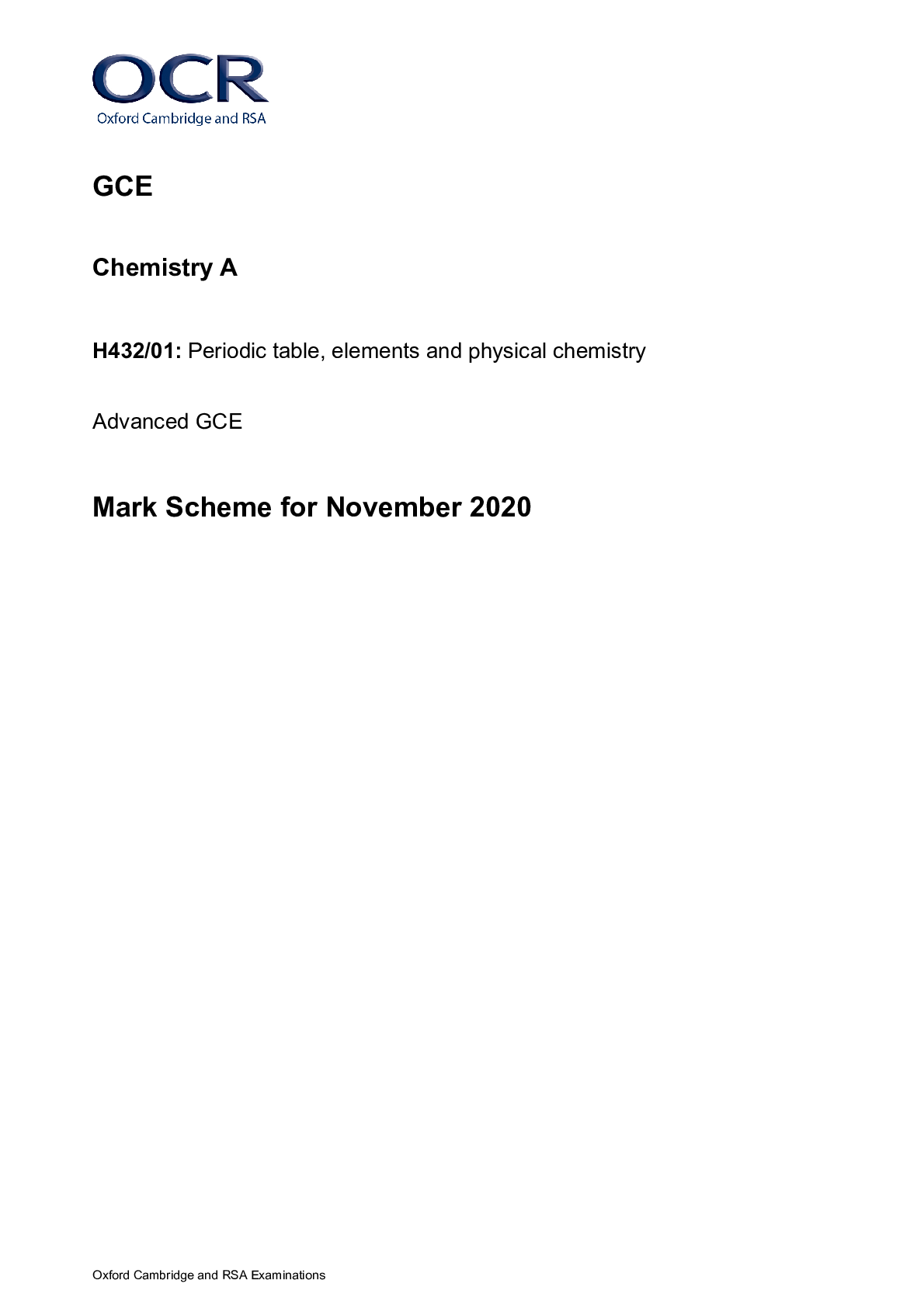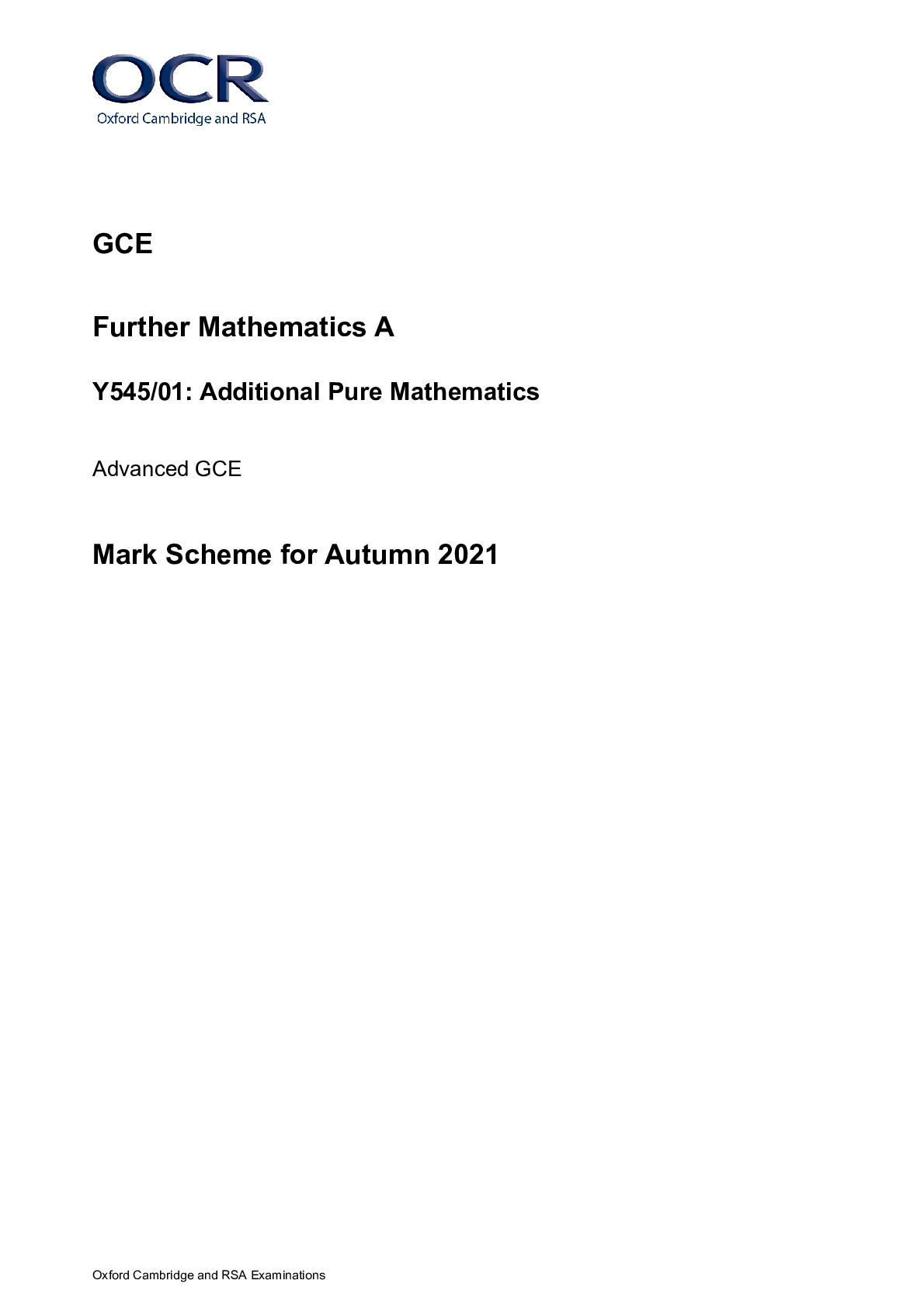History > AS Mark Scheme > GCE History A Y249/01: Russia 1894-1941 Advanced Subsidiary GCE Mark Scheme for November 2020 (All)
GCE History A Y249/01: Russia 1894-1941 Advanced Subsidiary GCE Mark Scheme for November 2020
Document Content and Description Below
Oxford Cambridge and RSA Examinations GCE History A Y249/01: Russia 1894-1941 Advanced Subsidiary GCE Mark Scheme for November 2020Oxford Cambridge and RSA Examinations OCR (Oxford Cambridge and... RSA) is a leading UK awarding body, providing a wide range of qualifications to meet the needs of candidates of all ages and abilities. OCR qualifications include AS/A Levels, Diplomas, GCSEs, Cambridge Nationals, Cambridge Technicals, Functional Skills, Key Skills, Entry Level qualifications, NVQs and vocational qualifications in areas such as IT, business, languages, teaching/training, administration and secretarial skills. It is also responsible for developing new specifications to meet national requirements and the needs of students and teachers. OCR is a not-for-profit organisation; any surplus made is invested back into the establishment to help towards the development of qualifications and support, which keep pace with the changing needs of today’s society. This mark scheme is published as an aid to teachers and students, to indicate the requirements of the examination. It shows the basis on which marks were awarded by examiners. It does not indicate the details of the discussions which took place at an examiners’ meeting before marking commenced. All examiners are instructed that alternative correct answers and unexpected approaches in candidates’ scripts must be given marks that fairly reflect the relevant knowledge and skills demonstrated. Mark schemes should be read in conjunction with the published question papers and the report on the examination. © OCR 2020Y249/01 Mark Scheme June 2020 2 Annotations Annotation Meaning of annotation Blank Page Highlight Off-page comment Assertion Analysis Evaluation Explanation Factor Illustrates/Describes Irrelevant, a significant amount of material that does not answer the question Judgement Knowledge and understanding Provenance Simple comment Unclear ViewY249/01 Mark Scheme June 2020 3 Subject Specific Marking Instructions Question Answer Mark Guidance 1* ‘Konstantin Pobedonostsev was the most influential person in Russia in the years from 1894 to 1914.’ How far do you agree? • In arguing that Konstantin Pobedonostsev was the most influential person in the Russian in the years 1894 to 1914, answers might consider how Pobedonostsev’s relationship with the autocratic Nicholas II – first as tutor and then as advisor – gave him vast influence over the Tsar; • Answers might consider how Pobedonostsev’s attitudes influenced government policy; for example his contempt for modernisation and democracy being reflected in the government’s unwillingness to reform the mir or grant political concessions; • Answers might consider Pobedonostsev’s position as Procurator-General of the Holy Synod, which gave him huge influence over the Orthodox Church and the daily lives of Russian peasants; • Answers might consider Pobedonostsev’s ability to act against those he saw as internal threats as demonstrating his influence, such as initiating pogroms, or in arranging the excommunication of Lev Tolstoy. • In arguing that Konstantin Pobedonostsev was not the most influential person in Russia in the years 1894 to 1914, answers might consider that the events of 1905-6 including the October Manifesto and 30 • No set answer is expected. • At Level 5 there will be a judgement as to the extent of influence. • At Level 5 answers might establish criteria against which to judge influence. • To be valid, judgements must be supported by relevant and accurate material. If not, they are assertions. • Knowledge must not be credited in isolation, it should only be credited where it is used as the basis for analysis and evaluation, in line with descriptions in the mark scheme. .Y249/01 Mark Scheme June 2020 4 Fundamental Laws marked an end to Pobedonostsev’s influence since they dismantled much of the system he argued should not be changed; • Answers might consider that Witte had more influence, since he was able to undertaken a programme of economic modernisation and persuade Nicholas to issue the October Manifesto despite the objections of Pobedonostsev; • Answers might consider the role of Stolypin, whose actions influenced the nature of Duma politics and Russian agriculture in the later part of the period and long after Pobedonostsev’s death in 1907; • Answers might consider the role of Tsar Nicholas II with whom ultimate power - and arguably influence - rested in Russia during this periodY249/01 Mark Scheme June 2020 5 Question Answer Mark Guidance 2* To what extent was the Kornilov Revolt the most important reason why the Bolsheviks were in a strong position to seize power by November 1917? • In arguing that the Kornilov Revolt was the most important reason why the Bolsheviks were in a strong position to seize power by November 1917, answers might consider that Kerensky’s decision to appoint Kornilov and inability to control him demonstrated the incompetence and weakness of the Provisional Government and turned more people against then, strengthening the Bolsheviks’ position; • Answers might consider that the Kornilov Revolt led to the release of Bolsheviks such as Trotsky who had been neutralised after the July Days, strengthening the Bolsheviks by returning them to activity; • Answers might consider that by arming the Bolsheviks to help defend Petrograd from Kornilov, the Provisional Government had strengthened the Bolsheviks by giving them the means to act against them in November; • Answers might consider that in the aftermath of the Kornilov Revolt it was the Bolsheviks rather than the Provisional Government who were seen as the defenders of Petrograd and so the Revolt increased the Bolsheviks’ credibility. • In arguing that other factors were more important, answers might consider that the Provisional Government had already made longer term decisions – such as the July 30 • No set answer is expected. • At Level 5 there will be a judgement as to the extent of importance • At Level 5 answers might establish criteria against which to judge ‘strong position’ • To be valid, judgements must be supported by relevant and accurate material. If not, they are assertions. • Knowledge must not be credited in isolation, it should only be credited where it is used as the basis for analysis and evaluation, in line with descriptions in the mark scheme.Y249/01 Mark Scheme June 2020 6 Offensive – that had damaged their reputation and strengthened that of the Bolsheviks; • Answers might consider that the Provisional Government’s unwillingness to withdraw from the war or address land reform had made Bolshevik demands more attractive to many • Answers might consider that it was the actions of Lenin since his return from exile that had allowed the Bolsheviks to be organised, decisive and appealing; • Answers might consider the role of Trotsky in the preparation and planning for the seizure of power, for example his position in the Military Revolutionary Committee; • Answers might consider the short term context of November 1917 including the decisions made by Kerensky in allowing the Bolsheviks to exploit the position to gain strength.Y249/01 Mark Scheme June 2020 7 Question Answer Mark Guidance 3 ‘The true test of Lenin’s leadership came in the years from 1918 to 1921. Lenin was able to overcome all the challenges he faced in this period.’ A Ascher, Russia: a Short History, 2009 Evaluate the strengths and limitations of this interpretation, making reference to other interpretations you have studied. • The historical debate centres around Lenin’s abilities as a leader between 1918 and 1921. • In analysing and evaluating the strength and limitations of the interpretation, alongside the main line of argument that Lenin was a successful leader of Russia between 1918 and 1921, answers might consider actions of Lenin that could be deemed failures. Answers may also challenge the interpretation through the consideration of areas where Lenin’s impact as a leader was limited, challenges that remained in 1921 and decisions made by Lenin that had a negative impact in Russia. • In analysing and evaluating the strengths of the given interpretation, answers might use knowledge and understanding of: • The positive short term impact of the Lenin Decrees in allowing the Bolsheviks’ survival in 1918; • Lenin’s use of terror in strengthening the Bolsheviks’ position in Russia, including the use of the Cheka;; 30 • No set answer is expected. • Candidates must use their knowledge and understanding of the historical context and the wider historical debate surrounding the issue to analyse and evaluate the given interpretation. • Candidates must refer to at least one other interpretation. • The quality of analysis and evaluation of the interpretations should be considered when assigning answers to a level, not the quantity of other interpretations used in the answer. • Other interpretations considered as part of evaluation and analysis do not need to be attributed to specific named historians, but they must be recognisable historical interpretations, rather than the candidate’s own viewpoint. • Answers may include more on strengths or more on limitations and there is no requirement for a 50/50 split in the evaluation, however for level 5 there should be well supported evaluation of both and for level 4 supported evaluation of both, in line with levels descriptors. • Candidates are not required to construct their own interpretation.Y249/01 Mark Scheme June 2020 8 • Lenin’s drive and willingness to enforce necessary but unpopular policy, such as signing the Treaty of Brest Litovsk; • Lenin’s economic pragmatism in abandoning to abandon War Communism in order to introduce necessary reform through NEP. • In analysing the limitations of the given interpretation, answers might use knowledge and understanding of: • Lenin’s decisions which could be deemed as failures, such as the contribution of Brest Litovsk and the closing of the Constituent Assembly to the start of the Civil War; • Lenin’s contribution to Red victory in the Civil War was far less significant than that of Trotsky; • Lenin’s ruthless drive and determination led to significant negative impacts and suffering in Russia, such as the huge human cost of famine as a result of War Communism; • Lenin continued to face challenges in 1921, not least from within the Bolsheviks themselves in opposition to NEP. • Other interpretations that might be used in evaluation of the given interpretation are: • Interpretations which recognise Lenin’s failures; • Interpretations which recognise Lenin’s limited role; • Interpretations which recognise the damaging impact on Russia of some of Lenin’s decisions; • Interpretations which recognise challenges remaining to Lenin in 1921.Y249/01 Mark Scheme June 2020 9 APPENDIX 1 – this contains a generic mark scheme grid AO1: Demonstrate, organise and communicate knowledge and understanding to analyse and evaluate the key features related to the periods studied, making substantiated judgements and exploring concepts, as relevant, of cause, consequence, change, continuity, similarity, difference and significance. Generic mark scheme for Section A, Questions 1 and 2: Essay [30] Level 5 25–30 marks There is a mostly consistent focus on the question. Generally accurate and detailed knowledge and understanding is demonstrated through most of the answer and is evaluated and analysed in order to reach substantiated judgements, but these are not consistently well-developed. There is a well-developed line of reasoning which is clear and logically structured. The information presented is relevant and in Level 4 19–24 marks The question is generally addressed. Generally accurate and sometimes detailed knowledge and understanding is demonstrated through most of the answer with evaluation and some analysis, and this is used appropriately to support the judgements that are made. There is a line of reasoning presented with some structure. The information presented is in the most-part relevant and supported by some evidence. Level 3 13–18 marks The question is partially addressed. There is demonstration of some relevant knowledge and understanding, which is evaluated and analysed in parts of the answer, but in places knowledge is imparted rather than being used. The analysis is appropriately linked to the judgements made, though the way in which it supports the judgements may not always be made explicit. Level 2 7–12 marks The focus is more on the topic than the specific demands of the question. Knowledge and understanding is limited and not well used, with only limited evaluation and analysis, which is only sometimes linked appropriately to the judgements made. The information has some relevance, but is communicated in an unstructured way. The information is supported by limited evidence and the relationship to the evidencemay not be clear. Level 1 1–6 marks The answer relates to the topic but not the specific question. The answer contains only very limited relevant knowledge which is evaluated and analysed in a very limited way. Judgements are unsupported and are not linked to analysis. Relevant knowledge is limited, generalised and poorly used; attempts at argument are no more than assertion. Information presented is basic and may be ambiguous or unstructured. The information is supported by limited evidence. 0 marks No evidence of understanding and no demonstration of any relevant knowledge.Y249/01 Mark Scheme June 2020 10 AO3: Analyse and evaluate, in relation to the historical context, different ways in which aspects of the past have been interpreted. Generic mark scheme for Section B, Question 3: Interpretation [20] Level 5 17–20 marks The answer has a very good analysis of the interpretation. It uses detailed and relevant knowledge of the historical context and shows thorough understanding of the wider historical debate, in the form of detailed examination of other interpretations, in order to produce a well-supported evaluation of both the strengths and weaknesses of the given interpretation. Level 4 13–16 marks The answer has a good analysis of the interpretation. It uses relevant knowledge of the historical context and good understanding of the wider historical debate, in the form of examination of other interpretations, in order to produce a supported evaluation of both the strengths and weaknesses of the given interpretation. Level 3 9–12 marks The answer has a partial analysis of the interpretation. It uses some relevant knowledge of the historical context and shows partial understanding of the wider historical debate, in the form of reference to other interpretations, in order to evaluate the strengths and weaknesses of the given interpretation. The evaluation may be un-even with only limited treatment of either limitations or strengths, Level 2 5–8 marks The answer has a limited analysis of the interpretation. It uses generalised knowledge of the historical context and shows limited understanding of the wider historical debate, in the form of generalised reference to other interpretations, in order to produce a limited evaluation of the given interpretation. The evaluation may deal with either strengths or limitations in a very superficial way, or Level 1 1–4 marks The answer has a very limited analysis of the interpretation which may be descriptive and relate more to the topic area than the detail of the interpretation. It uses very limited and generalised knowledge of the historical context and shows very limited or no understanding of the wider historical debate, with reference to other interpretations being implicit or lacking, in order to produce a very simplistic, asserted evaluation of the given interpretation. 0 marks No evidence of understanding or reference to the interpretation.OCR (Oxford Cambridge and RSA Examinations) The Triangle Building Shaftesbury Road Cambridge CB2 8EA [Show More]
Last updated: 1 year ago
Preview 1 out of 12 pages
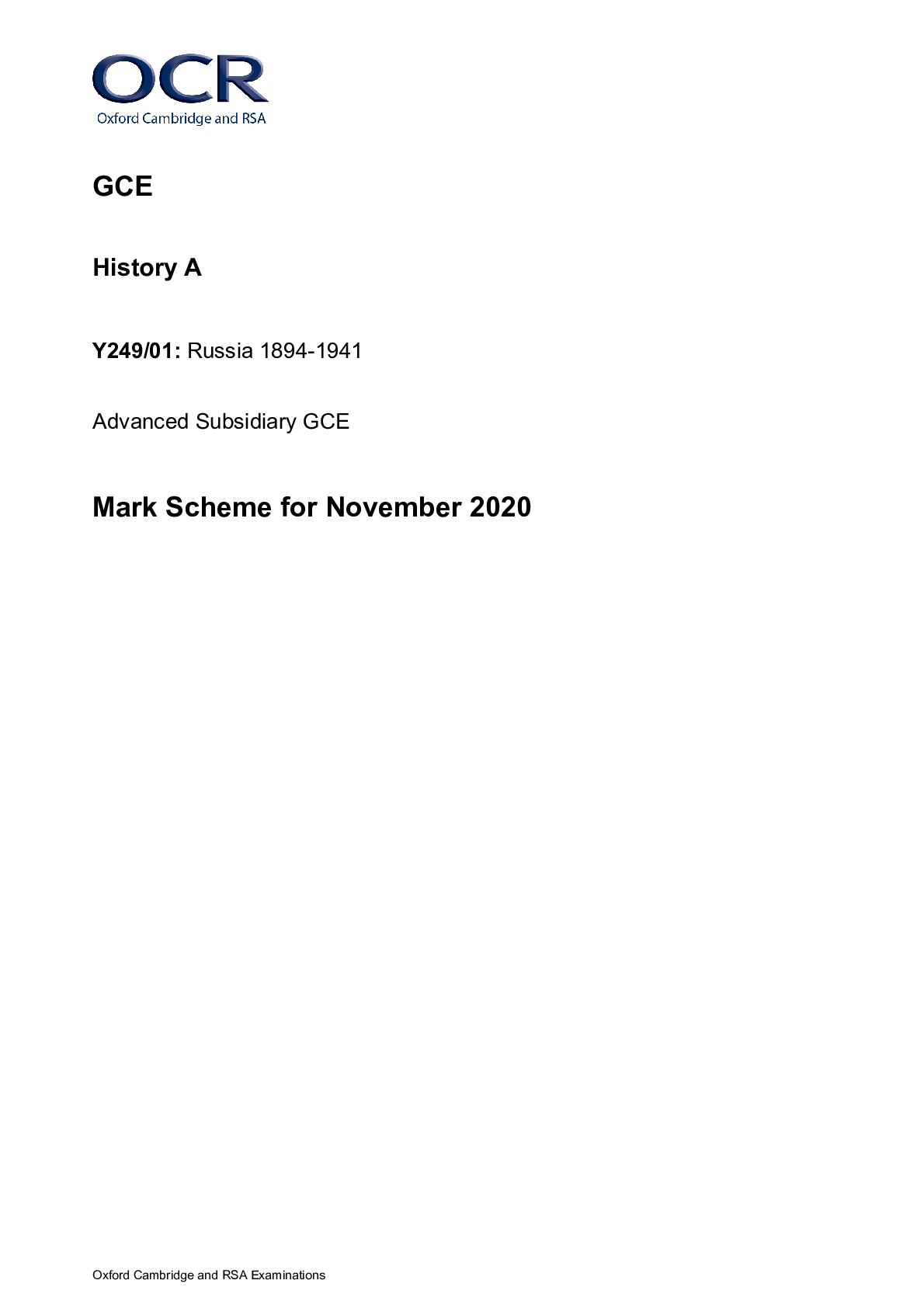
Reviews( 0 )
Document information
Connected school, study & course
About the document
Uploaded On
Oct 10, 2022
Number of pages
12
Written in
Additional information
This document has been written for:
Uploaded
Oct 10, 2022
Downloads
0
Views
34

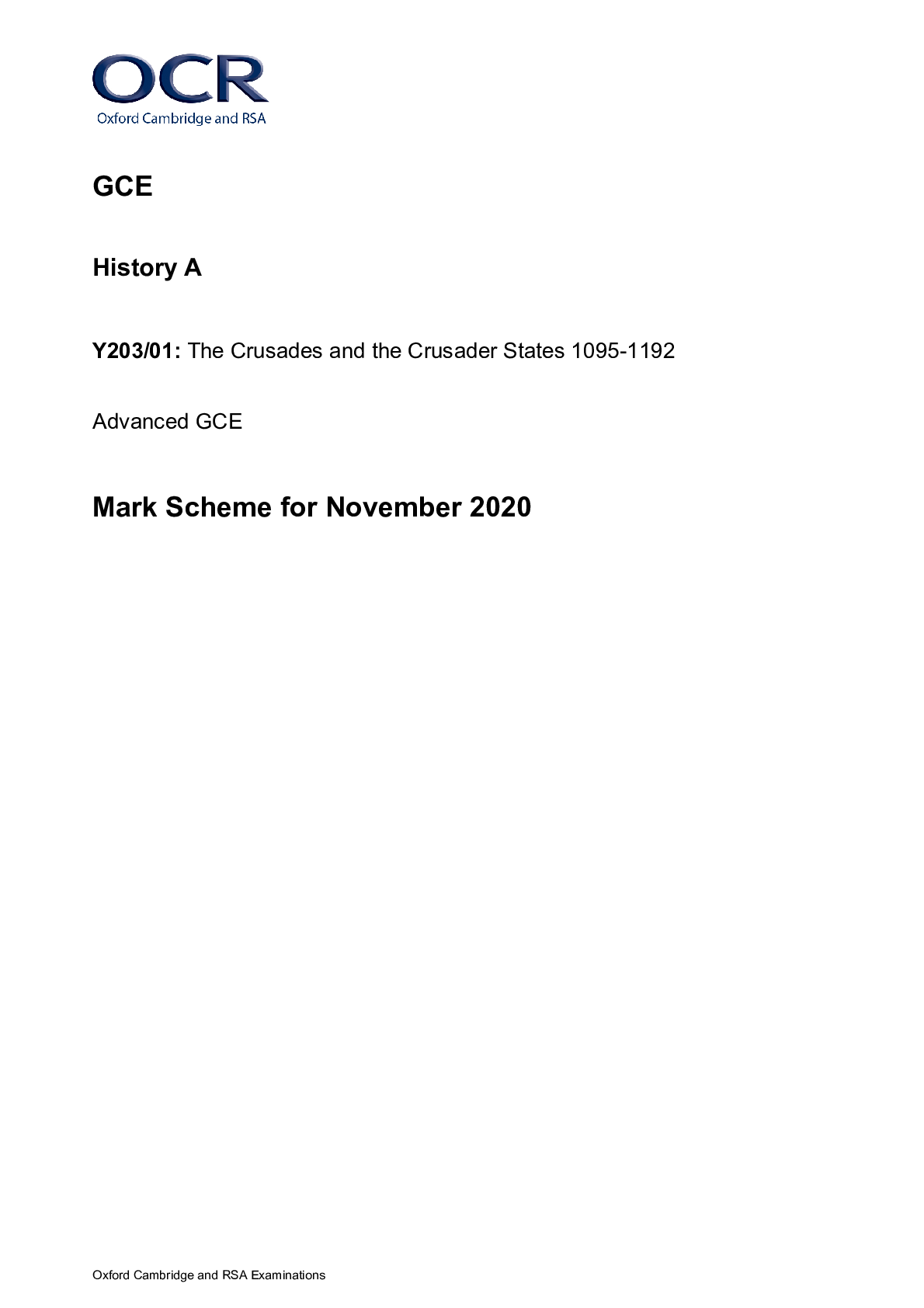
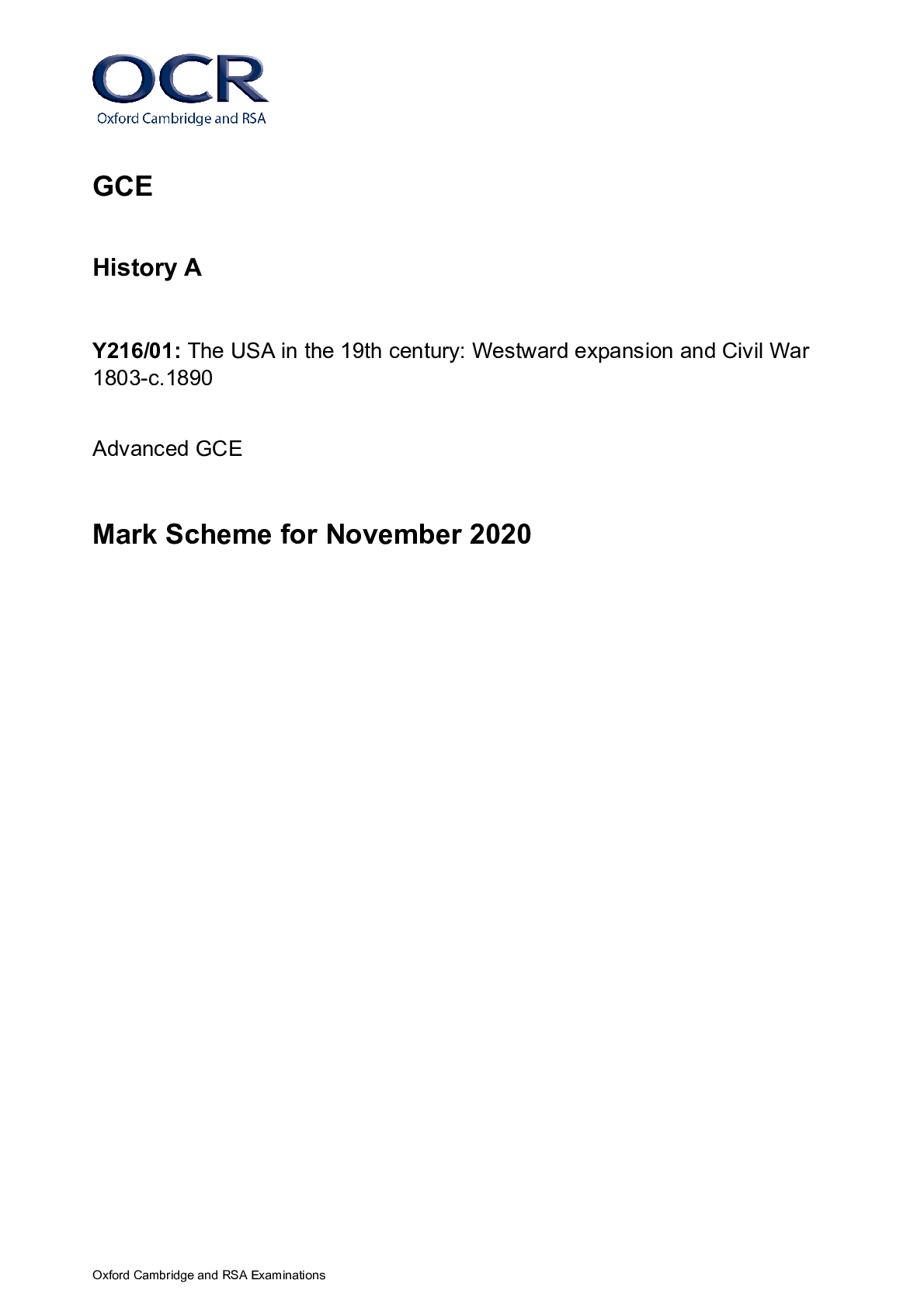
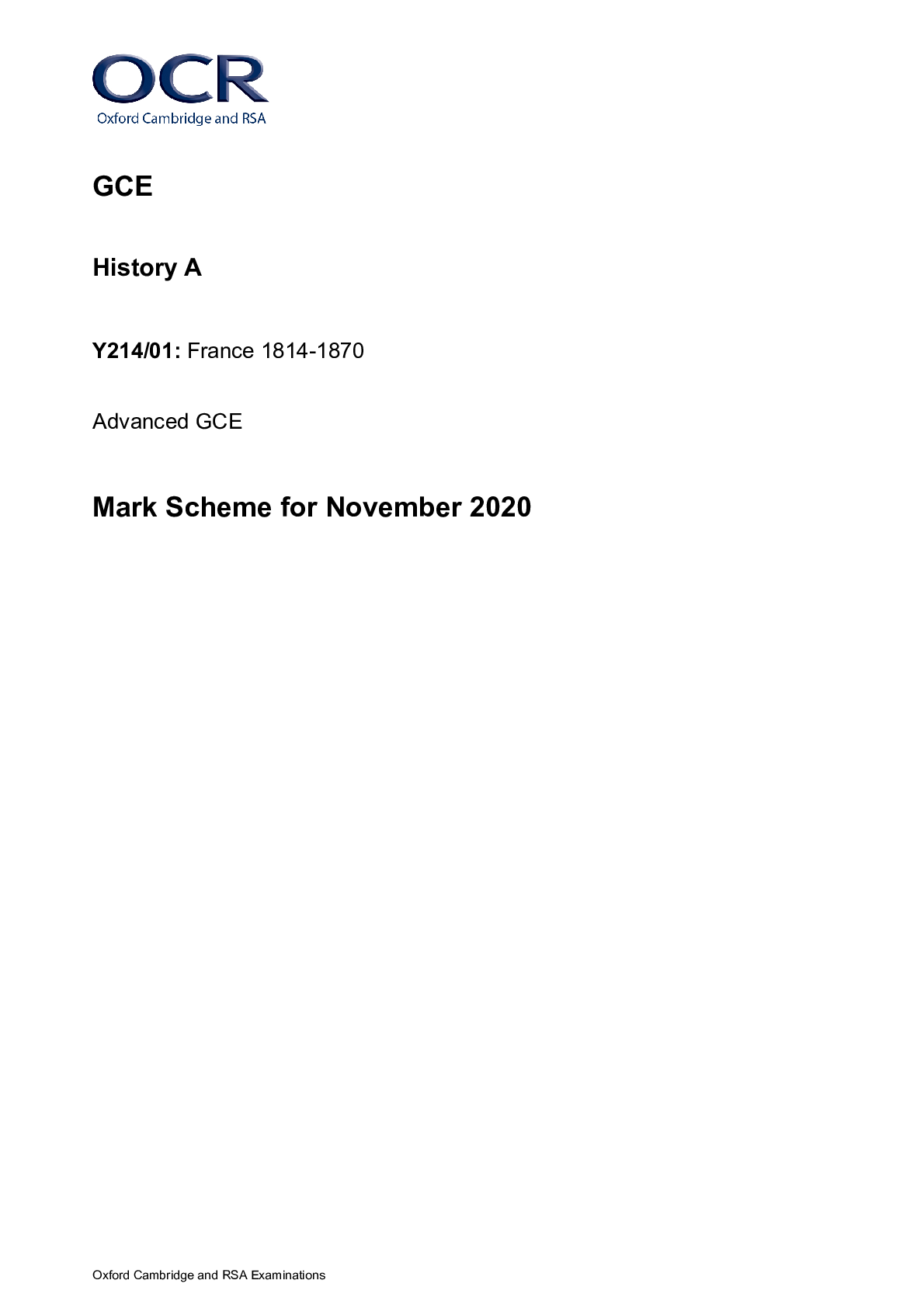



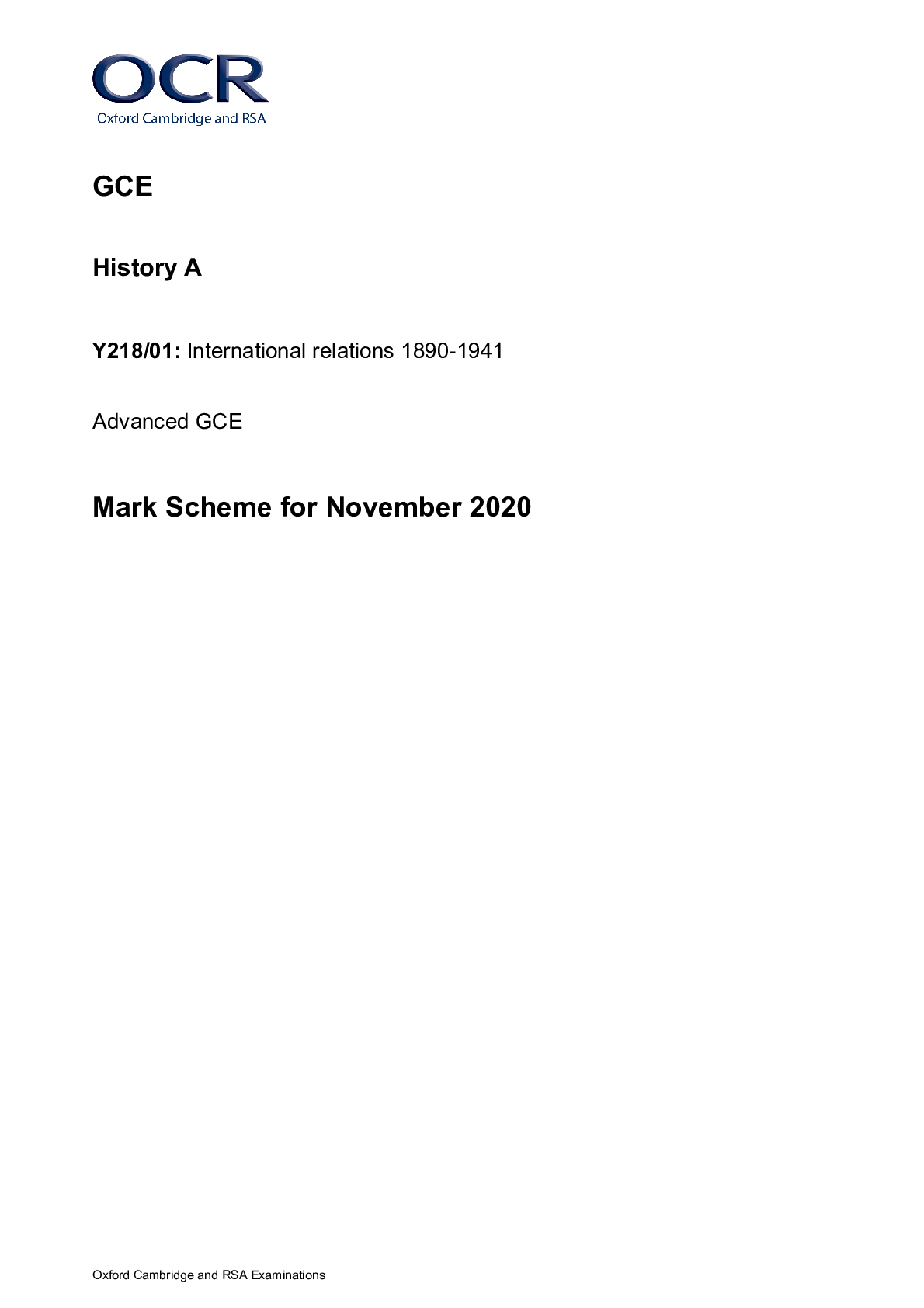
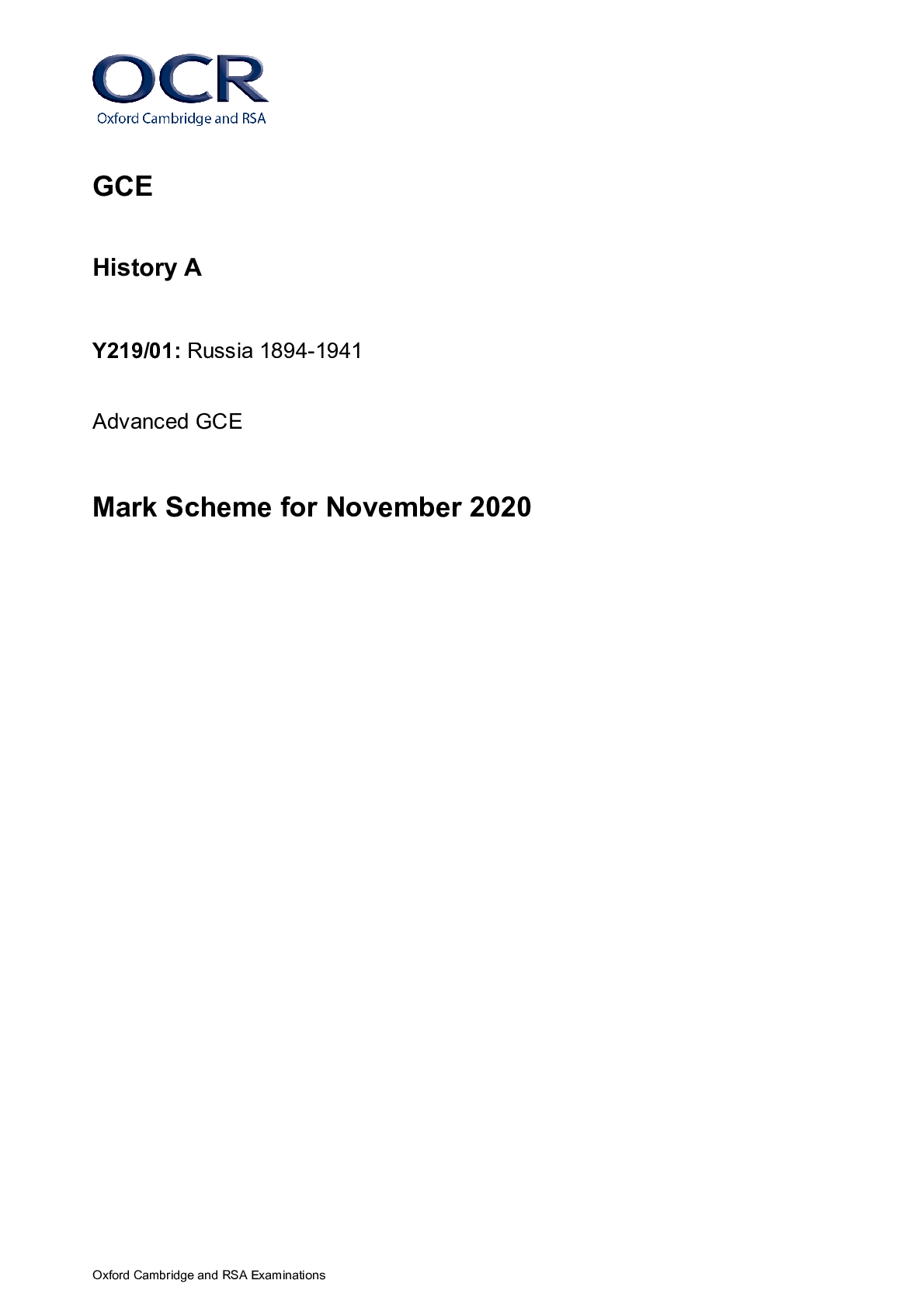







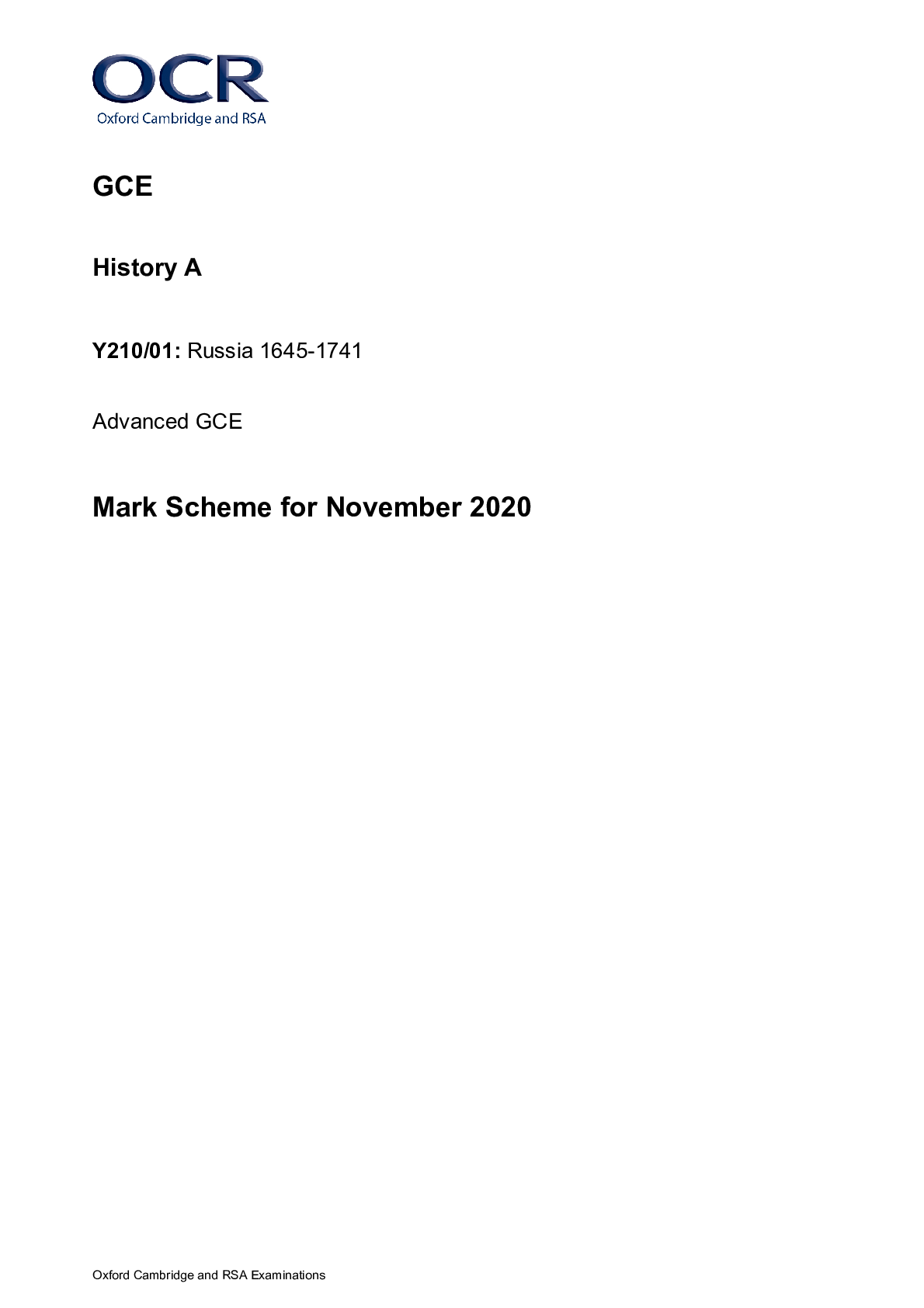


.png)

